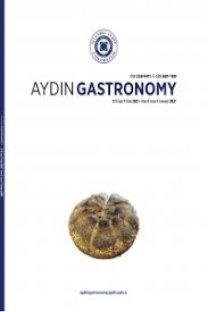Moleküler Gastronomi Bakış Açısıyla Gıdaların Tat ve Aroma Algıları
Beslenme ve gastronomide gıdaların kalite kontrolleri duyusal olarak değerlendirilir. Buda gıdaların kalite karakterlerinin görme, koklama, tatma veya dokunma duyularının tepkilerini ölçen bir analiz yöntemidir. Duyusal değerlendirme de tat ve aroma en önde gelir. Gastronomi birçok bilim dalıyla ilişkili olup özellikle yemek olgusunu birçok alanla birleştirerek yemek yemeyi faklı boyutlara taşımaktadır. Gastronomi ile aynı zamanda yemek ile kültür arasında bir bağ kurduğundan yemek ve kültür kavramını birleştiren bir olgudur. Moleküler Gastronomi ise gıdaların üretimi, hazırlanması veya depolanması sırasında tat, koku, lezzet ve aromasını ve daha geniş manası ile kimyasal ve biyokimyasal yapılarında oluşabilecek olan değişmeleri inceler. Duyusal değerlendirme ve gastronomide tat alma duyusu dilimizin üzerindeki alıcı sinir uçları sayesinde gerçekleşmektedir. Genel olarak tatlı, ekşi, acı ve tuzlu olmak üzere dört farklı ana tat algısı kabul edilir. Ancak son çeyrek asırda bu dört tattan başka acımtırak, buruk ve umami diye adlandırılan tatlarda tanımlanmıştır. Bu yüzden dilimizin tat haritasının belki yeniden tanımlanmaya ihtiyacı vardır
Taste and Aroma Perceptions of Foods from the Perspective of Molecular Gastronomy
The quality control of food in gastronomy and nutrition is evaluated by sensory evaluation. This is an analysis method which measures the reactions of the senses of smell, taste or touch to see the character of the food quality. Taste and aroma are among the leading factors in sensory evaluation which is used to determine the acceptability of the food. Gastronomy is associated with many disciplines especially the fact of foods combining with many fields bears eating to different dimensions. Due to the gastronomy also establishes a link between food and culture, it is a phenomenon that combines the concept of food and culture. Molecular Gastronomy is a food demonstrated by scientific studies examining the changes which may occur in taste, smell and aromas and more broadly with the chemical and biochemical structure during the production of food, the preparation or storage. Taste perversion is realized in sensory evaluation receiver through nerve endings on our tongue. The overall sweet, sour, bitter and salty are considered as four the main flavor perception. However, a part from these four flavors; bitterish, acrid and umami tastes are defined in so-called in the last quarter century. So the map taste of our tongue perhaps needs to be redefined
